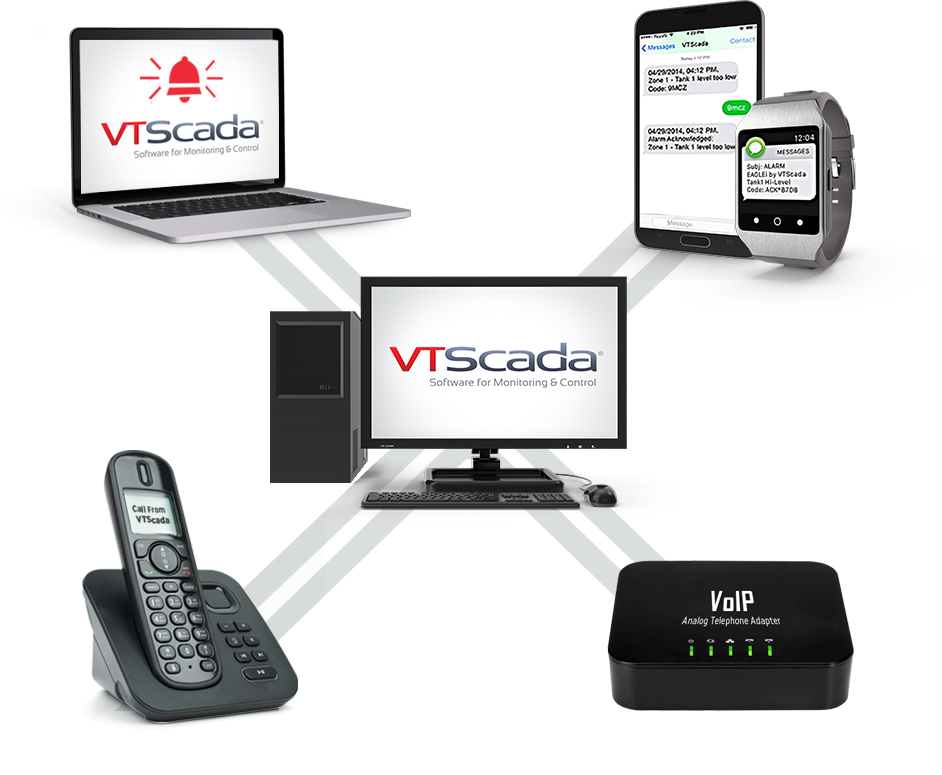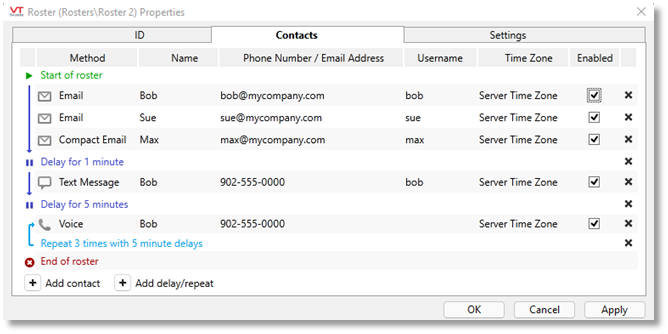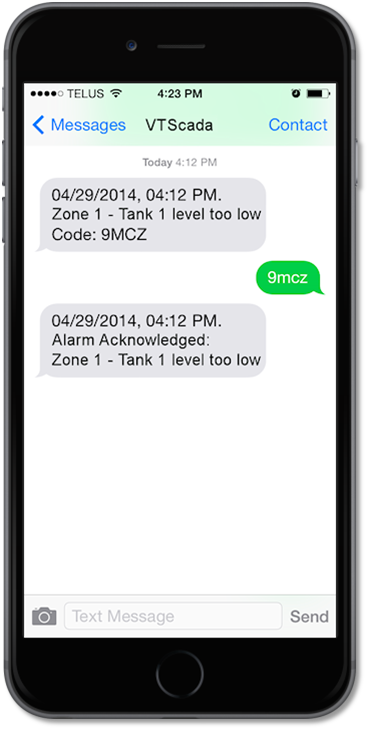Optional Component
A fully integrated solution designed to work seamlessly for the life of your system.
Today’s SCADA operators are too busy in the field to have time to sit looking at screens all day waiting for problems to occur. When alarms happen, the system needs to be able to get that information to the right person as soon as possible no matter where they might be.

The VTScada® Alarm Notification System (ANS) transmits alarm information anywhere via text-to-voice phone calls, SMS text messages, emails and pagers. Dial into your application using your application security account to check levels, acknowledge alarms, change setpoints, or send commands to equipment.
Built-In is Better
VTScada’s unique integrated approach to alarm notification vastly reduces integration time and ensures tight compatibility over the entire life of your SCADA system no matter what version you are running. Add ANS to any VTScada Runtime or Development Runtime license by simply updating your VTScada software key. The ANS shares the same tag and alarm databases as the VTScada application.
Note: Alarm and event management is part of every VTScada application. The built-in SCADA alarm notification features described on this page are optional.
New in VTScada 12.1 – Annunciate Voice Alerts over VoIP, no modem or Internet
VTScada will continue to support physical voice modems for text-to-speech alarm annunciation while they are available. However, it is increasingly difficult to find companies that produce them. Worse, telecom providers are phasing out support for data over analog lines. Version 12.1 lets you move beyond this hardware and take advantage of the benefits of VoIP without going through the internet.
Rosters help to ensure no alarm goes unacknowledged
When an alarm goes unacknowledged for a user-defined period, VTScada won’t stop until it finds an authorized person to acknowledge it. The system begins working its way through rosters of up to 30 contacts each. A contact is a combination of a staff member and a method of notification such as SMS text message, email, or over the phone via text-to-speech voice engine.
This means you can create a contact for your cell phone and another for your landline. Configure any number of rosters for the whole application or specific functional areas. Roster activations are recorded as events in the alarm history.

New in VTScada 12.1 – Alarm Notification/Roster Enhancements
Version 12.1 makes it even easier to ensure your critical alarms find you anywhere.
- Clearer and Easier Configuration – The Roster Properties dialog has been revamped to make it easier to organize the contacts.
- Drag-and-drop Reordering – This includes the ability to easily reorder contacts in the roster via drag-and-drop.
- Custom Callout Delays – Rather than a single delay between roster callouts, you can now set a custom wait time for each contact.
- Notification Bursts – Custom delays allow multiple contacts to be notified in one “burst” by setting no delay between them.
- Repeat Groups of Contacts – One or more contacts can be repeated in a roster without having to add them multiple times.
Dial-In Phone Access
Dial-in from anywhere to log in and use the auto-generated spoken menu’s system to hear system values (e.g., well levels), perform control actions (e.g., start pump 1), and receive or acknowledge a list of alarms.
 Acknowledge by SMS, email, or text-to-voice
Acknowledge by SMS, email, or text-to-voice
Once you are notified of an alarm via SMS text message, email, or text-to-voice phone call, you can easily acknowledge it the same way and stop VTScada from sending further notifications.
Crystal Clear Text-to-speech
VTScada uses the Microsoft® Speech API (SAPI). In addition to providing the latest in text-to-speech technology, SAPI simplifies our licensing and significantly reduces the size of the VTScada installer.
Voice Modem Support
VTScada should work with any standard voice modem. Though we cannot guarantee the compatibility of third-party modems across all Windows operating systems our engineers have identified modems that they have used or have been used by our customers on our VTScada Support Forum. Their comments can be found on our VTScada Support Forum.
Advanced Modem Management
VTScada collects modems from all application servers into a single pool. VTScada searches this pool, rather than a specific server, for an appropriate data or voice modem to use when sending alarms.
Introduced in 11.3 – Optional VOIP using Twilio®
Having a difficult time sourcing physical voice modems? Do your modems work poorly over lines meant for voice communication? Having trouble configuring reliable modem redundancy when using virtual machines? The VTScada Alarm Notification System now optionally supports voice telephony alarm notification functionality using Twilio**, a paid web-based communications platform. This requires SCADA access to the Internet and a Twilio account.
Running VTScada as a Service?
This feature introduced in version 11.1 allows VTScada to optionally run in the background without an active user interface. Please note that Microsoft does not permit Windows services to access SAPI, the built-in Windows text-to-speech engine. This means that if you’re using the VTScada Alarm Notification System and you have configured your application to run as a service, the outgoing alarm calls will be silent. In this case, we recommend using Twilio (above) for alarm annunciation.This is not an issue for standard VTScada installations.
Automatic SCADA Alarm Notification Failover
Server failover is an important factor in ensuring uptime and accessibility. This extends to alarm notification. Easily create lists of backup alarm notification servers that will automatically and seamlessly take over if the primary is unavailable. Responsibility will return to the primary server when it is restored.
Application-level Security
Secure access on incoming and outgoing calls is maintained through the use of the standard VTScada Security Manager. To receive status or alarm information, users are prompted by VTScada for their password. Users who do not have the ‘Alarm Acknowledge’ security privilege will not be able to acknowledge alarms.
Mobile Alarm Management
VTScada Thin Clients VTScada Thin Clients (licensed separately) allow you to securely view and acknowledge alarms anywhere using PCs, or HTML5 compliant mobile devices.
** Twilio licensed separately. Requires a VTScada license with Alarm Notification System enabled. Not supported by VTScadaLIGHT. Twilio and Twilio logo are trademarks of Twilio, Inc.
